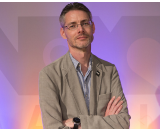 James Cridland, radio futurologist, is a conference speaker, writer and consultant. He runs the media information website media.info and helps organise the yearly Next Radio conference. He also publishes podnews.net, a daily briefing on podcasting and on-demand, and writes a weekly international radio trends newsletter, at james.crid.land.
James Cridland, radio futurologist, is a conference speaker, writer and consultant. He runs the media information website media.info and helps organise the yearly Next Radio conference. He also publishes podnews.net, a daily briefing on podcasting and on-demand, and writes a weekly international radio trends newsletter, at james.crid.land.
 |
| Every time I sit down and write one of these newsletters, something else happens that represents a seismic shift in radio. This time, it was the removal at the beginning of September of many local radio stations by Bauer Media, the UK’s #2 commercial radio group. 40 local radio stations disappeared this month, mostly replaced with Bauer’s networked Greatest Hits Radio station, which plays oldies and is not the same as Hits Radio, which doesn’t. Local newspaper websites – which are, of course, competition – were quick to quote disappointed listeners.
Realistically, it had to happen. Even if some of the stations that have been shut did a great job in terms of audience, it’s any commercial radio company’s job to earn revenue. Unlike manufacturing, radio has a fixed cost – the transmitters, buildings and DJs cost the same whether there are 10 or 10 million people listening. And sadly local radio doesn’t always mean a lot of revenue, even if you do have good audience figures. I’m sad about some of the stations that are no longer part of the UK’s radio landscape; but I can understand the business decision to replace even successful stations with Greatest Hits Radio. If you want to take a listen, here’s Greatest Hits Radio West Yorkshire, which is on a plethora of AM and FM frequencies, as well as DAB, across the county that I worked in for many years. It’ll ask for a UK postcode – confuse them by typing Bauer didn’t do what I was expecting – move Simon Mayo to Greatest Hits breakfast. A big national name, on Radio 1 breakfast in the late 1980s, is currently sidelined on a failed classical radio station from the company. They’ve given him an album show on a Sunday afternoon; and breakfast is done by the I’m sure quite competent but unknown-to-me Rossie. Mayo at breakfast, while his personal brand is still high after leaving the BBC only a few years ago? Seems a no-brainer; but perhaps he doesn’t want to do it. It’s not just Bauer ripping out local programming. In Australia, Southern Cross Austereo, the country’s biggest commercial broadcaster, also axed hundreds of broadcasters – axing 19 regional breakfast shows on their top-40-and-recent-oldies Hit network. Most stations outside the capital cities are now being given a state-wide breakfast show; to put that in context, Queensland (where I live) is 64 times as big as Massachusetts, as well as being rather easier to spell and quite a lot hotter. To drive from Port Douglas to the city of Gold Coast in Queensland takes twenty-one hours to drive the 1,190 miles; yet much of this sun-kissed land will now have the same breakfast show (which in many cases was the only local piece of output anyway). Shame. And, again, understandable. Nicely, an Australian radio podcast Game Changers Radio ▸ is now focusing on helping people to take their skills and knowledge from radio to new opportunities. It’s worth a listen, wherever you are.
|
| What I’m up to
Ah, remember travel? I’m a writer, consultant, and an amazingly brilliant keynote speaker for your radio conference, setting an innovative and optimistic feel for your event by sharing how radio is changing round the world – in terms of consumption, production and promotion. If I can help you, or your business, please do get in touch, by simply hitting ‘reply’. |
